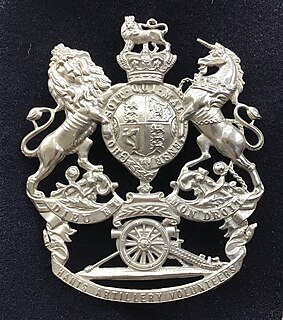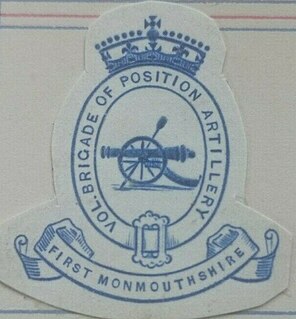
The 1st Wessex Artillery was a volunteer unit of the British Army that existed under various titles from 1860 to 1971, including active service in Mesopotamia in World War I and North Africa and Italy in World War II.
The 1st Fife Artillery Volunteers, later the Highland (Fifeshire) Heavy Battery, was a volunteer unit first recruited in Fifeshire, Scotland, in 1860, which fought on the Western Front in the First World War. Its successor units expanded recruitment to Aberdeenshire and again fought in North West Europe, during the Second World War.

The 1st Devonshire Artillery Volunteers and its successor units served in the British Army's Reserve Forces from 1859 to 1961. During World War I it carried out garrison duty in British India but went on to see active service in the Third Anglo-Afghan War. Converting to an air defence role before World War II its units participated in the Norwegian campaign and the Dunkirk evacuation, the Battle of Britain and then the campaigns in North Africa, Italy, and Burma

The 1st Midlothian Artillery Volunteer Corps was formed in 1859 as a response to a French invasion threat. Originally it served as garrison and heavy artillery but transferred to the Territorial Force (TF) in 1908 as field artillery, in which role it served through both World Wars. In World War I it fought on the Western Front with 51st (Highland) Division. In World War II it briefly saw service in France after Dunkirk and was with Eighth Army in North Africa and Italy. Its wartime duplicate regiment served with distinction in the Burma Campaign. Postwar the regiment continued in existence until amalgamation in 1967.

The 1st Ayrshire and Galloway Artillery Volunteer Corps was formed in 1859 as a response to a French invasion threat. It transferred to the Territorial Force (TF) in 1908 and its successor units fought with the 52nd (Lowland) Infantry Division in Palestine during World War I, and in North West Europe and Burma during World War II. It continued in the Territorial Army (TA) until amalgamation in 1967.

The 1st Monmouthshire Artillery Volunteer Corps was a unit of Britain's Volunteer Force raised in 1860 from Monmouthshire in the Welsh borders. After transfer to the Territorial Force it served with the 53rd (Welsh) Division in Palestine in World War I and in North West Europe in World War II. Its successors serve with today's Army Reserve.

The Forth Royal Garrison Artillery and its successors were Scottish part-time coast defence units of the British Army from 1908 to 1956. Although they saw no active service, they supplied trained gunners to siege batteries engaged on the Western Front during World War I.

The 1st Hampshire Artillery Volunteers and its successors were part-time coast defence units of the British Army from 1860 to 1967. Although the units saw no action, they protected the Portsmouth area in both World Wars and supplied trained gunners to siege batteries engaged on the Western Front during World War I. The unit continued in the Territorial Army after World War II.

The Northern Division, Royal Artillery, was an administrative grouping of garrison units of the Royal Artillery, Artillery Militia and Artillery Volunteers within the British Army's Northern District from 1882 to 1889.

The Lancashire Division, Royal Artillery, was an administrative grouping of garrison units of the Royal Artillery, Artillery Militia and Artillery Volunteers within the British Army's Northern District from 1882 to 1889.

The Cinque Ports Division, Royal Artillery was an administrative grouping of garrison units of the Royal Artillery, Artillery Militia and Artillery Volunteers within the British Army's South Eastern District from 1882 to 1889.

The London Division, Royal Artillery, was an administrative grouping of garrison units of the Royal Artillery and Artillery Volunteers within the British Army's Home and Woolwich Districts from 1882 to 1889.

The Welsh Division, Royal Artillery, was an administrative grouping of garrison units of the Royal Artillery, Artillery Militia and Artillery Volunteers in the British Army's Western District from 1882 to 1889.

The North Irish Division, Royal Artillery, was an administrative grouping of garrison units of the Royal Artillery and Artillery Militia in Ireland from 1882 to 1889.

The South Irish Division, Royal Artillery, was an administrative grouping of garrison units of the Royal Artillery and Artillery Militia in Ireland from 1882 to 1889.

The Eastern Division, Royal Artillery, was an administrative grouping of garrison units of the Royal Artillery, Artillery Militia and Artillery Volunteers within the British Army's Eastern District from 1882 to 1902.

The Southern Division, Royal Artillery, was an administrative grouping of garrison units of the Royal Artillery, Artillery Militia and Artillery Volunteers within the British Army's Southern District from 1882 to 1902.

The 'Western Division, Royal Artillery,' was an administrative grouping of garrison units of the Royal Artillery, Artillery Militia and Artillery Volunteers within the British Army's Western District from 1882 to 1902.

The Mountain Division, Royal Artillery, was an administrative grouping of mountain artillery units of the Royal Artillery from 1889. It continued as a distinct branch of the Royal Garrison Artillery until World War I.







